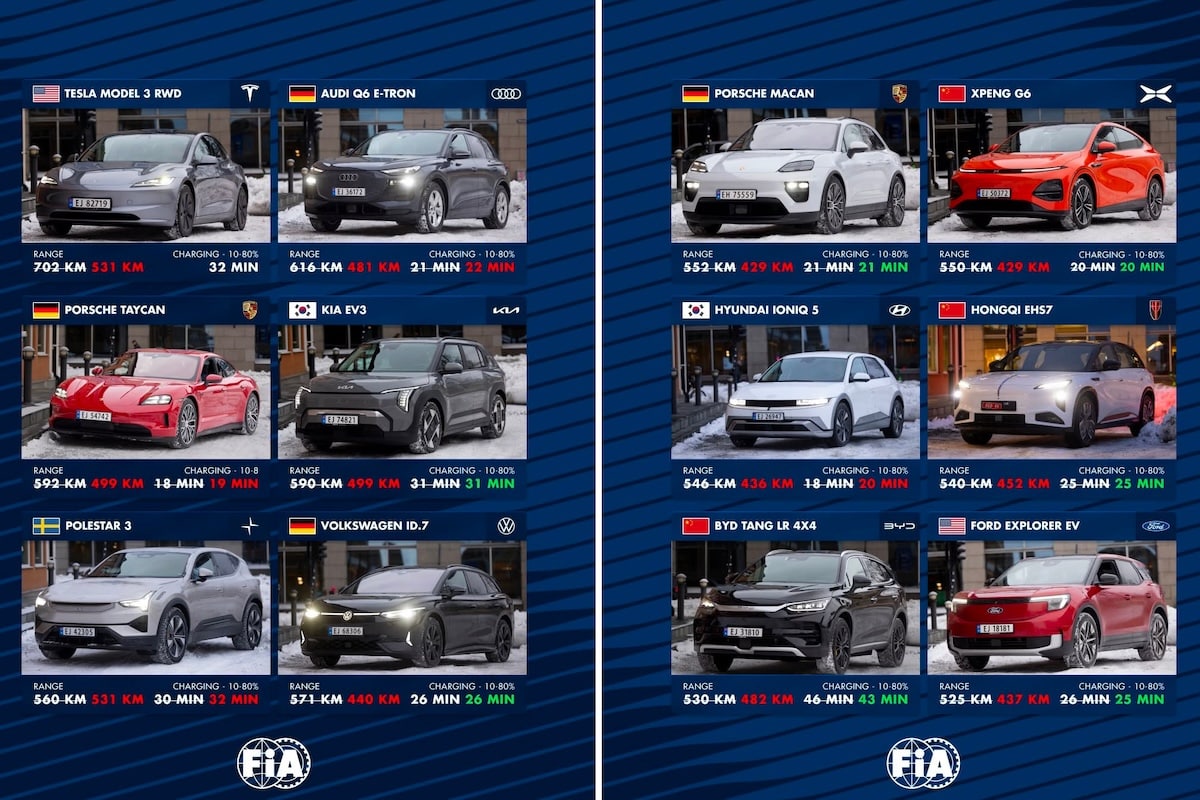The FIA tests 24 electric cars in the harsh cold… and exposes Tesla

The International Automobile Federation gathered 24 electric cars in Norway to confront them with the cold. The results are surprising.
Such rigorous tests, using the same protocol and with no financial interest in the outcomes, are quite rare. Yet, this is the exercise that the FIA, the prestigious International Automobile Federation, undertook in Norway in early January 2025.
The goal was to confront 24 electric cars with the reality of extreme cold, focusing on range and charging speed. And between promises and reality, there are often significant gaps. Some cars perform better than others.
THE SELECTED CARS
- Tesla Model 3 Rear-wheel Drive
- Audi Q6 e-tron
- Porsche Taycan
- KIA EV3
- Polestar 3
- Volkswagen ID.7 Station Wagon
- Porsche Macan
- Xpeng G6
- Hyundai Ioniq 5
- Hongqi EHS7
- BYD Tang LR 4×4
- Ford Explorer
- Peugeot E-5008
- Yoyah Dream
- Volvo EX30
- Mercedes G-Class
- Smart #3
- Mini Countryman
- Peugeot E-3008
- NIO EL8
- BYD Sealion 7
- BYD Seal U
- Lotus Emeya S
- BMW i5
RESULTS AND RANGE VARIATIONS
| Promised Range (KM) | Actual Range (KM) | Drop | |
| Tesla Model 3 Rear-wheel Drive LR | 702 | 531 | -24.30% |
| Audi Q6 e-tron | 616 | 481 | -21.90% |
| Porsche Taycan | 592 | 499 | -15.70% |
| KIA EV3 | 590 | 499 | -15.40% |
| Polestar 3 | 560 | 531 | -5.10% |
| Volkswagen ID.7 Station Wagon | 571 | 440 | -22.90% |
| Porsche Macan | 552 | 429 | -22.20% |
| Xpeng G6 | 550 | 429 | -22.00% |
| Hyundai Ioniq 5 | 546 | 436 | -20.10% |
| Hongqi EHS7 | 540 | 452 | -16.20% |
| BYD Tang LR 4×4 | 530 | 482 | -9.00% |
| Ford Explorer | 525 | 437 | -16.70% |
| Peugeot E-5008 | 488 | 361 | -26.00% |
| Yoyah Dream | 482 | 344 | -28.60% |
| Volvo EX30 | 472 | 371 | -21.30% |
| Mercedes G-Class | 443 | 381 | -13.90% |
| Smart #3 | 415 | 346 | -16.60% |
| Mini Countryman | 399 | 355 | -11.00% |
| Peugeot E-3008 | 510 | 347 | -31.90% |
| NIO EL8 | 503 | 412 | -18.00% |
| BYD Sealion 7 | 502 | 436 | -13.10% |
| BYD Seal U | 500 | 421 | -15.80% |
| Lotus Emeya S | 500 | 436 | -12.80% |
| BMW i5 | 497 | 392 | -21.10% |
The initial lessons are quite surprising. First, we observe that the range of the Tesla Model 3 Long Range Rear-wheel Drive collapses the most among this comparison, with the highest percentage decrease. Another noteworthy point is the extremely poor performance of the Peugeot E-5008 and E-3008, with declines of nearly -32%! Even unknown Chinese manufacturers (Hongqi, Yoyah) do not perform that badly.
CHARGING SPEED RESULTS FROM 10% TO 80%
| Promised Charging Time (min) | Actual Charging Time (min) | Difference | |
| Tesla Model 3 Rear-wheel Drive LR | 32 | 32 | = |
| Audi Q6 e-tron | 21 | 22 | +1 min |
| Porsche Taycan | 18 | 19 | +1 min |
| KIA EV3 | 31 | 31 | = |
| Polestar 3 | 30 | 32 | +2 min |
| Volkswagen ID.7 Station Wagon | 26 | 26 | = |
| Porsche Macan | 21 | 21 | = |
| Xpeng G6 | 20 | 20 | = |
| Hyundai Ioniq 5 | 18 | 20 | +2 min |
| Hongqi EHS7 | 25 | 25 | = |
| BYD Tang LR 4×4 | 46 | 43 | -3 min |
| Ford Explorer | 26 | 25 | -1 min |
| Peugeot E-5008 | 30 | 39 | +9 min |
| Yoyah Dream | 36 | 43 | +7 min |
| Volvo EX30 | 26 | 28 | +2 min |
| Mercedes G-Class | 32 | 33 | +1 min |
| Smart #3 | 30 | 31 | +1 min |
| Mini Countryman | 30 | 29 | -1 min |
| Peugeot E-3008 | 30 | 47 | +17 min |
| NIO EL8 | 20 | 21 | +1 min |
| BYD Sealion 7 | 24 | 31 | +7 min |
| BYD Seal U | 43 | 42 | -1 min |
| Lotus Emeya S | 18 | 16 | -2 min |
| BMW i5 | 30 | 33 | +3 min |
Once again, two groups are evident: vehicles that accurately meet their commercial promise, and those that perform lamentably. Peugeot, especially the E-3008, stands out with an +17-minute increase compared to the brochure… while the actual range afterward is one of the lowest. That’s quite significant…
On the other hand, the Lotus Emeya S is a charging speed champion, requiring only 16 minutes before being ready to go again for about 300 km. The Porsche Taycan is also quite good because its range is subsequently higher. With 32 minutes of stopping from 10% to 80%, the Tesla Model 3 is not among the fastest to recharge. Additionally, BYD vehicles generally recharge slowly in cold weather.




READ ALSO: Volvo slashes the EX30 with an immediate €4,000 discount!
This page is translated from the original post "La FIA teste 24 électriques dans le grand froid… et démasque Tesla" in French.
We also suggestthese articles:
Also read





